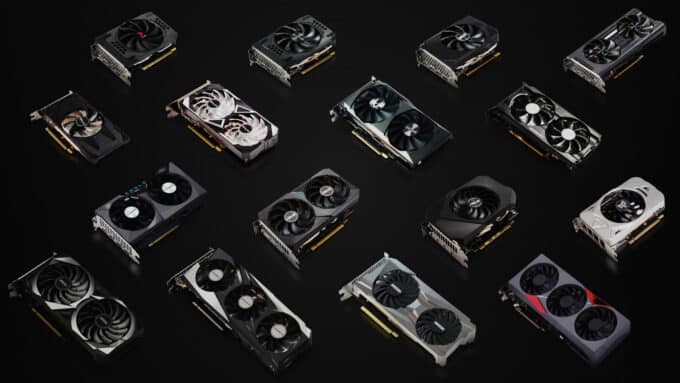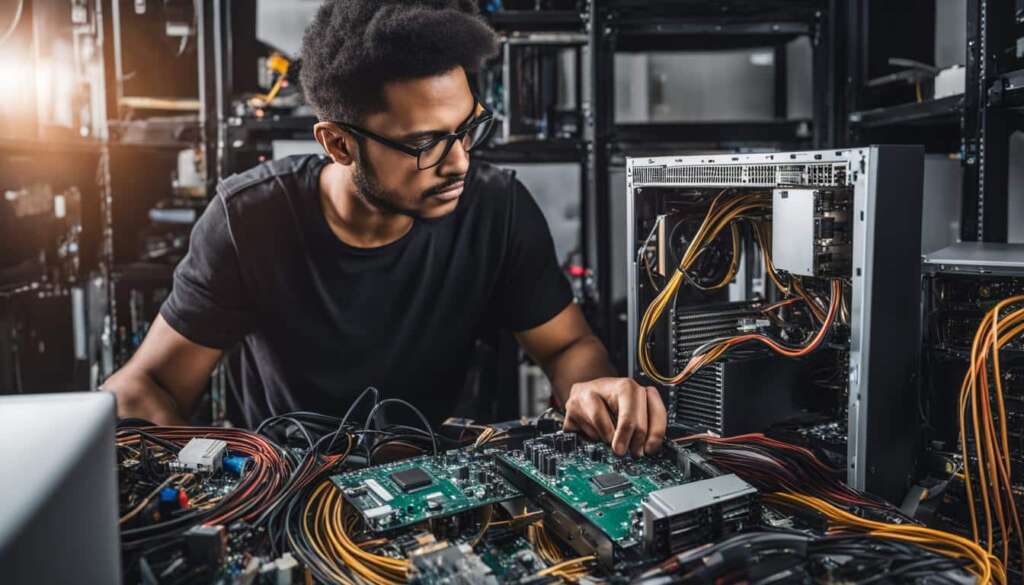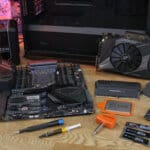In today’s digital landscape, the importance of Choosing the Right Graphics Card cannot be overstated. As the cornerstone of visual rendering, the graphics card breathes life into our digital experiences, from the vibrancy of 4K movies to the immersive depths of cutting-edge gaming. But with an expansive array of models, brands, and technical specifications on the market, making the right choice can often be a daunting endeavor. This guide is designed to simplify that decision, ensuring that individuals and professionals alike make informed choices. Whether you’re gearing up for high-end gaming, intricate design work, or just seamless everyday computing, understanding the nuances of Choosing the Right Graphics Card can be the difference between a stellar experience and a mediocre one. Dive in as we illuminate the path to optimal visual performance tailored to your distinct needs.
1. Pinpointing Your Needs: The Comprehensive Guide to Choosing the Right Graphics Card
When it comes to Choosing the Right Graphics Card, understanding your unique requirements is the linchpin. A well-chosen GPU can drastically enhance your computing experience, so here’s a deeper look into various use-case scenarios:
- Gaming:
- Resolution Matters: If you’re playing at 1080p, you might not need the latest high-end card. However, for 4K gaming or VR, a more powerful GPU becomes essential.
- Refresh Rates: Gamers looking to exploit 144Hz or higher monitors should ensure their GPU can push the frames required, especially in the latest AAA titles.
- Future Games: Keep in mind upcoming game releases. Buying a card that barely meets the requirements of current games might not fare well in a year or two.
- Content Creation:
- Software Compatibility: Ensure the GPU you’re considering is optimized for the software you frequently use, like Adobe Suite, Blender, or Autodesk.
- Rendering & Compute Performance: If you’re into 3D modeling or video editing, look for cards with good compute performance. CUDA cores (Nvidia) or Stream Processors (AMD) numbers can be a good indicator.
- Stable Drivers: Professionals need stability. Ensure the manufacturer has a reputation for providing regular driver updates and patches.
- General Use & Productivity:
- Multiple Displays: For multitasking across several monitors, ensure the GPU supports multiple display outputs.
- Integrated vs. Dedicated: For simple tasks, modern CPUs with integrated graphics might suffice. But for better multi-monitor support or smoother video playback, consider a dedicated entry-level GPU.
- Energy Efficiency: If you’re concerned about electricity bills or wish to maintain a quieter workspace, look for energy-efficient models that don’t demand significant power or cooling.
By dissecting and understanding these facets of your computing requirements, you’re not only safeguarding your investment but also ensuring a smooth, responsive, and enjoyable user experience. Remember, Choosing the Right Graphics Card is about finding that sweet spot between overkill and underperformance.
2. Budgetary Boundaries: Maximizing Value for Every Quid Spent
When it comes to hardware investments, balancing performance with budget is crucial. Your financial constraints play a pivotal role, but that doesn’t mean compromising on quality or performance. Here’s how to ensure you’re getting the most out of your investment:
- Price Tiers: Graphics cards typically fall into three main price categories:
- Entry-Level (£50-£150): Suitable for general tasks, light gaming, and multimedia playback. These won’t handle modern AAA games at high settings but are perfect for less demanding tasks.
- Mid-Range (£150-£400): A favorite choice for many users. These cards run most games at 1080p with good frame rates and are suitable for budding content creators.
- High-End (£400 and above): Targeted at enthusiasts and professionals. Ideal for 4K gaming, VR, and demanding content creation projects.
- Cost-to-Performance Ratio: The allure of the latest models is strong, yet sometimes, a slightly older model can offer considerable performance at a fraction of the cost. Always compare benchmarks and performance reviews.
- Hidden Costs: Some additional expenses might come your way, such as:
- Power Consumption: A more powerful GPU might need a better power supply unit or could raise your electricity costs.
- Cooling: Stronger GPUs emit more heat, which might mean investing in better cooling solutions.
- Sales and Discounts: Stay alert for promotional periods, especially during major sales events or when a new series is on the horizon. This can be a golden opportunity to snag a deal.
- Used Market: For those open to it, the pre-owned market can offer notable savings. Ensure the card is in good condition and ideally, that there’s a return or warranty option.
A mindful approach to your budget ensures a rewarding purchase. It’s about smart spending, ensuring you gain exceptional performance without any regrets.
3. Technical Specifications: Navigating the Numbers
At the heart of your decision-making process is understanding the technical jargon that accompanies graphics card descriptions. These specifications are pivotal in determining the capability and performance of the card:
- GPU Architecture: Brands like NVIDIA and AMD often release new architectures that bring significant improvements in performance, power efficiency, and features. Familiarize yourself with names like Turing, RDNA, or Pascal to know the generation and capabilities.
- VRAM (Video RAM): This is the memory used to store image data. For gaming at 1080p, 4GB is typically sufficient. However, 4K gaming, VR, or professional content creation might demand 8GB or more.
- Core Clock and Boost Clock: Measured in MHz, these define the speed at which the GPU runs. A higher number typically means better performance, but it’s essential to consider alongside other specs.
- CUDA Cores/Stream Processors: These are the parallel processors in the GPU. NVIDIA uses the term CUDA cores, while AMD refers to them as Stream Processors. Generally, more cores mean better performance, but efficiency also plays a role.
- TDP (Thermal Design Power): This metric denotes the amount of heat the GPU will produce when operating at its maximum capacity. It can help determine the kind of cooling solution you’ll need.
- DirectX and Vulkan Support: These are graphics APIs used by games and applications. Ensure your GPU supports the latest versions for better compatibility and performance.
- Ray Tracing and DLSS: Ray tracing provides more realistic lighting and reflections. DLSS (Deep Learning Super Sampling) by NVIDIA uses AI to upscale images, allowing higher resolutions with less computational demand. While these features might not be essential for everyone, they can enhance gaming and visualization experiences.
- Connectivity Options: Depending on your monitor setup, check for HDMI, DisplayPort, and DVI options. Also, consider if the card supports multi-monitor setups if that’s a requirement for you.
Technical specifications provide a roadmap to a GPU’s potential and its suitability for your tasks. While numbers can be daunting, understanding their relevance ensures you’re well-equipped to make an informed choice, guaranteeing a smoother and more responsive experience.
To delve deeper into the intricacies of graphics card specifications, you can refer to the comprehensive Wikipedia page on Graphics Processing Unit. Understanding these technical details ensures that you’re well-equipped to make an informed choice, guaranteeing a smoother and more responsive experience.
4. Compatibility Checks: Ensuring Your System is Graphics Card Ready
Before you make the leap into acquiring a new graphics card, it’s crucial to ensure that your existing system can accommodate it seamlessly. Here’s a breakdown of compatibility factors to consider:
- Power Supply Unit (PSU) Capacity: Take a look at your power supply unit’s wattage. High-performance graphics cards often require more power. Ensure your PSU can handle the increased load to prevent system instability or crashes.
- Physical Space: Graphics cards come in various sizes, and some high-end models can be quite large. Measure the available space inside your computer case to guarantee that the chosen GPU fits comfortably without obstructing other components or airflow.
- Motherboard Compatibility: Different graphics cards use different interfaces. Most modern GPUs use PCIe slots, but the version (e.g., PCIe 3.0, PCIe 4.0) can vary. Check your motherboard’s compatibility to ensure it has the right slot for the GPU you’re considering.
- Connectivity: Confirm that the graphics card you choose has the necessary video outputs to match your monitor or display setup. Common options include HDMI, DisplayPort, and DVI.
- Cooling and Airflow: High-performance GPUs generate more heat, requiring adequate cooling. Ensure that your case has proper airflow and, if needed, consider additional cooling solutions like fans or liquid cooling.
- Driver and Software Support: Verify that the GPU you’re eyeing is well-supported by your operating system. Check the manufacturer’s website for the latest drivers and software updates to guarantee compatibility.
- BIOS/UEFI Updates: In some cases, a BIOS or UEFI update might be necessary to ensure smooth GPU integration, especially when dealing with newer graphics cards on older motherboards. Check your motherboard manufacturer’s website for updates.
- System Bottlenecks: Be mindful of potential bottlenecks in your system. If your CPU or RAM is significantly outdated compared to your new GPU, it could limit overall performance. Consider upgrading other components if needed.
- Warranty and Return Policy: Finally, always read the warranty and return policy of the graphics card you’re purchasing. This ensures that if any compatibility issues or defects arise, you have recourse for resolution.
By conducting these comprehensive compatibility checks, you’ll be well-prepared to integrate your new graphics card seamlessly into your system, ensuring a hassle-free and optimized experience.
5. Brand Considerations: Making an Informed Choice
Choosing the right graphics card extends beyond just picking the model or specs; the manufacturer or brand also plays a significant role in your overall experience. Here’s why brand considerations matter:
- Driver Support: Different manufacturers provide driver support at varying levels of consistency and reliability. Established brands like NVIDIA and AMD often offer regular driver updates, enhancing compatibility and optimizing performance for the latest games and software. Staying up-to-date is crucial for a smooth user experience.
- Customer Support and Warranty: Consider the quality of customer support and warranty services offered by the brand. A robust warranty can be a lifesaver in case of unexpected issues. Read reviews and forums to gauge user experiences with customer support.
- Build Quality and Cooling Solutions: Some manufacturers design graphics cards with superior build quality and advanced cooling solutions. These features can impact not only the card’s durability but also its ability to maintain lower temperatures and quieter operation under heavy loads.
- Aesthetics: While not a primary concern for everyone, aesthetics matter to some users who want their GPU to match the overall look of their PC build. Different brands offer various designs and RGB lighting options.
- Pricing and Availability: Graphics card prices and availability can fluctuate between brands. Be open to exploring different manufacturers to find a card that meets your budget and is readily available.
- Brand Reputation: Research the brand’s reputation within the tech community. User reviews, expert opinions, and forum discussions can provide insights into the brand’s track record for delivering quality products.
- Third-Party Card Designs: Some manufacturers offer third-party designs of popular GPUs, often with enhanced cooling solutions or factory overclocks. These cards can provide an extra edge in performance and thermals.
- Overclocking Support: If you’re into overclocking for added performance, certain brands might offer better support and features for this. Look for models designed with overclocking in mind.
It’s essential to strike a balance between the specific GPU model and the brand’s reputation and offerings. A reputable manufacturer not only ensures a well-constructed card but also provides ongoing support and peace of mind for your investment.
6. Reviews and Benchmarks: The Power of Informed Decision-Making
When you’re on the verge of selecting a graphics card, knowledge is your most potent ally. Turning to reviews and benchmarks can provide you with invaluable insights that go beyond technical specifications. Here’s why they matter:
- Real-World Performance: Benchmarks and reviews offer a glimpse into how a graphics card performs in real-world scenarios. They provide data on frame rates, rendering quality, and thermal performance across a range of games and applications.
- Comparative Analysis: By comparing multiple graphics cards, you can determine which one offers the best value for your specific use case. Reviews often stack up several models side by side, making it easier to spot strengths and weaknesses.
- Identifying Limitations: Reviews can reveal potential limitations of a graphics card, such as thermal throttling under heavy loads or compatibility issues with certain games or software.
- User Feedback: Reading user reviews and forums can offer additional insights into a card’s performance and reliability. It’s a chance to learn from others who have hands-on experience with the product.
- Driver Updates: Reviews often discuss the performance improvements introduced through driver updates. This information can help you gauge a graphics card’s longevity and continued optimization.
- Ray Tracing and DLSS Performance: If ray tracing and DLSS are of interest, reviews can detail how well a card handles these advanced features, offering a glimpse into the future of gaming visuals.
- Noise and Temperature: Reviews typically measure noise levels and temperature under load. This information is critical if you’re sensitive to noise or concerned about your system’s thermals.
- Consider Multiple Sources: To form a well-rounded opinion, consult multiple sources for reviews and benchmarks. Different reviewers may use varying testing methodologies or focus on different aspects of performance.
- Watch Video Reviews: Video reviews can provide visual demonstrations of a graphics card’s performance and features, making it easier to grasp its capabilities.
- Keep an Eye on Futureproofing: Some reviews may discuss a graphics card’s potential for future games and software. This is particularly relevant if you want your investment to remain relevant for years to come.
By leveraging reviews and benchmarks, you can make an informed decision based on real-world performance and user experiences, ensuring that the graphics card you select aligns precisely with your needs and expectations.
7. Future-Proofing: Planning Ahead for Upcoming Demands
The world of technology is ever-evolving, and what’s considered cutting-edge today might become standard tomorrow. When choosing a graphics card, it’s wise to consider future demands to ensure your investment stands the test of time. Here’s how to future-proof your choice:
- Monitor Upgrades: If you plan to upgrade your monitor to higher resolutions (e.g., from 1080p to 4K) or higher refresh rates (e.g., from 60Hz to 144Hz or beyond), select a graphics card that can handle these advancements without strain.
- Game Requirements: Keep an eye on upcoming game titles and their system requirements. While your graphics card may handle current games admirably, upcoming AAA titles may demand more graphical prowess. Ensuring your card exceeds the recommended specifications can extend its relevance.
- Content Creation: If you’re a content creator, consider the trajectory of software demands. Video editing and 3D modeling applications continually evolve, often requiring more powerful GPUs for optimal performance.
- VR and Ray Tracing: Virtual reality and ray tracing technologies are becoming more prevalent. If you’re interested in these immersive experiences, opt for a card that supports them to ensure compatibility with future VR headsets and games.
- PCIe Interface: Stay aware of the PCIe interface versions. While PCIe 3.0 is common, newer motherboards support PCIe 4.0, offering faster data transfer speeds. A card that supports the latest PCIe standards ensures compatibility with future motherboards.
- RAM and VRAM: As software becomes more demanding, having sufficient RAM and VRAM is essential. Consider a graphics card with ample VRAM to accommodate future game textures and content creation tasks.
- Ecosystem Compatibility: If you’re invested in a specific ecosystem, such as NVIDIA’s G-Sync or AMD’s FreeSync, ensure your graphics card aligns with your monitor and other hardware.
- Upgrade Path: Some graphics card series allow for incremental upgrades. For example, if you buy a mid-range card now, you might be able to upgrade to a more powerful model in the same series later without changing your entire system.
- Manufacturer’s Roadmap: Keep an eye on the manufacturer’s roadmap for upcoming releases. Knowing when a new series or architecture is expected can help you time your purchase strategically.
While future-proofing is a prudent approach, it’s essential to strike a balance. Don’t overspend on features you might not use in the near future. Instead, focus on ensuring your graphics card has the headroom to accommodate upcoming demands while still serving your current needs effectively.
By considering future requirements, you can extend the lifespan of your graphics card, maximizing the value of your investment and ensuring it remains relevant as technology continues to advance.
8. Sustainability and Energy Efficiency: Minimizing Environmental Impact
As the world becomes increasingly conscious of environmental sustainability, it’s essential to consider the eco-friendliness of your hardware choices, including your graphics card. Here’s how to make a greener choice when selecting a graphics card:
- Energy Efficiency: Graphics cards come with different power requirements. Opt for models that are energy-efficient and have earned certifications such as “Energy Star” or “80 PLUS” for power supplies. This not only reduces your electricity bills but also lessens your carbon footprint.
- Manufacturing Practices: Research the manufacturer’s commitment to sustainable and ethical manufacturing practices. Some companies are more dedicated to minimizing waste, reducing emissions, and ensuring ethical labor standards throughout the supply chain.
- Recyclability: Consider how easily a graphics card can be recycled at the end of its lifecycle. Look for products with recyclable materials and eco-friendly packaging.
- Longevity: Investing in a high-quality graphics card with a longer lifespan reduces the frequency of replacements, reducing e-waste. Look for models known for their durability.
- Fanless or Passive Cooling: Some graphics cards utilize passive cooling solutions or fanless designs, reducing noise pollution and energy consumption. These options are particularly appealing for those seeking quieter PC setups.
- Local Regulations: Be aware of any local regulations or incentives related to energy-efficient hardware. Some regions offer tax incentives or rebates for purchasing environmentally friendly products.
- Resale or Donation: Consider giving your old graphics card a second life by selling it or donating it to someone who can still benefit from its performance. This extends the product’s useful life and reduces waste.
- Carbon Offsets: Some manufacturers and organizations offer carbon offset programs, allowing you to mitigate the environmental impact of your graphics card purchase by supporting carbon reduction projects.
- User Behavior: While not directly related to the graphics card itself, adopting energy-efficient practices, such as turning off your PC when not in use or optimizing power settings, can further reduce your environmental footprint.
By prioritizing sustainability and energy efficiency in your graphics card choice, you not only contribute to a greener planet but also potentially save on long-term energy costs. It’s a win-win scenario that aligns your technology needs with your environmental values.
Conclusion: Your Informed Graphics Card Choice
Choosing the right graphics card is pivotal for your digital experience. By understanding your needs, budget, and the technical aspects, you can make an informed decision. Compatibility, brand reputation, and reviews play crucial roles, while future-proofing and sustainability ensure your investment lasts. So, choose wisely and embrace the limitless possibilities of your tech journey.







